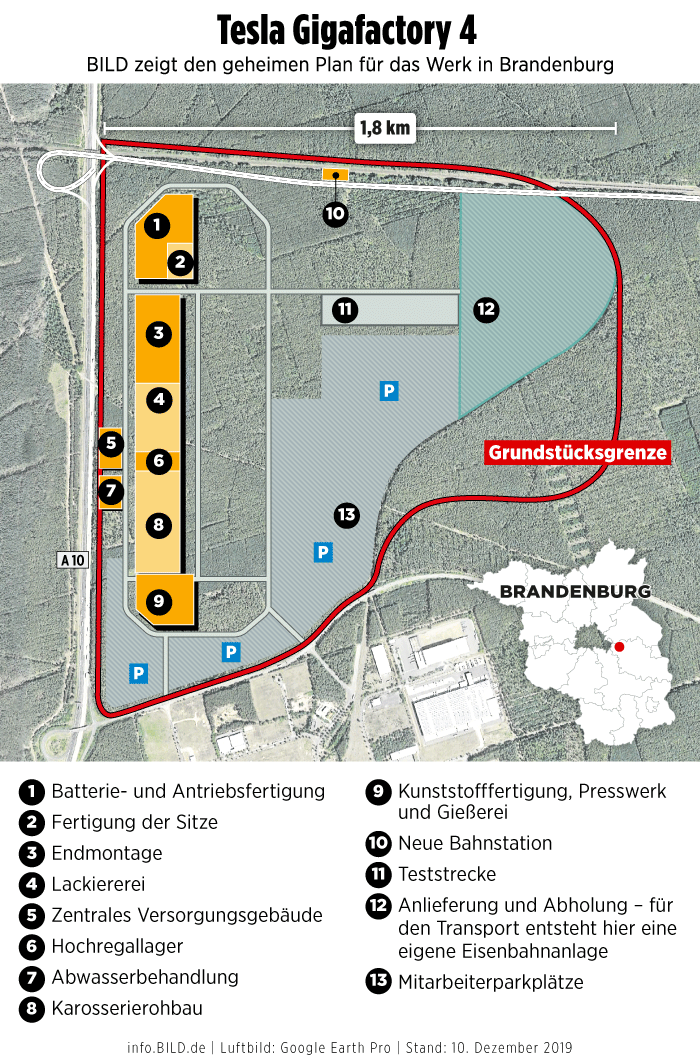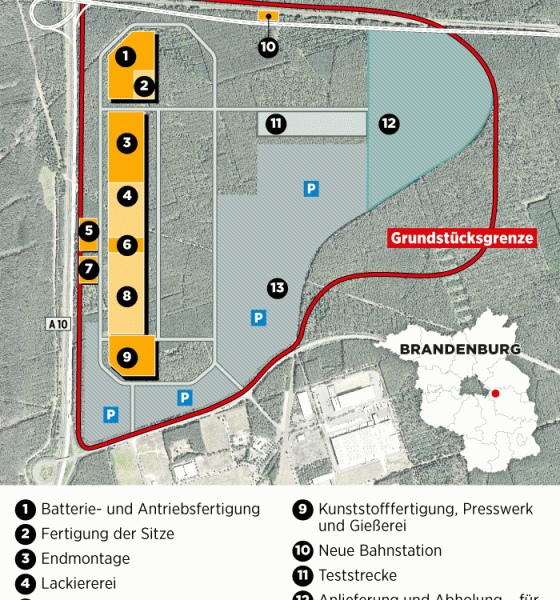

News
Tesla Gigafactory 4 complex to include on-site train station: report
Tesla Gigafactory 4 may have its own train station, based on recent reports from Germany.
German publication Bild recently shared what appeared to be the layout of Gigafactory 4, which will be built in Brandenburg, a town roughly an hour east of Berlin. The image depicted several parts of the upcoming facility, including its battery and drivetrain assembly, seat assembly, and final assembly area. It also showed a train station and a possible Autobahn exit.
Tesla has not confirmed if Bild‘s information about Gigafactory Berlin is accurate, but if it holds water, the upcoming facility may very well prove to be one of the company’s most efficient factories yet. A train station provides the company with easy transportation of cargo and materials, while access to the Autobahn will allow easy deliveries of vehicles. Workers from nearby cities would likely find it easier to get to the facility as well.
that's interesting, a new 🚉 train station.
and a new AUTOBAHN 🚗 north of the site..😳👍#Gigafactory4 #Gruenheide pic.twitter.com/ToCerOJg9K— Gigafactory Berlin News (@Gf4Tesla) December 11, 2019
Below is a quick translation of the labels on the factory layout above as shared by Twitter user @xDreamCoding.
1 battery and drivetrain assembly
2 seat assembly
3 final assembly
4 paintshop
5 central supplybuilding
6 high rack warehouse
7 wastewater treatment
8 body shell
9 plastic stamping and foundry
10 new trainstation
11 test track
12 delivery and collection
13 staff parking lot— Dr Eam Co Ding (@xDreamCoding) December 11, 2019
Recent job postings hint that the electric car manufacturer may plan to produce its own battery cells in the upcoming facility. According to the listing, Tesla is looking for a senior process engineering lead who will be able to help create “novel detailed designs for a wide range of systems from electrolyte to high purity water, involving unit operations such as pump and compressor systems, reverse osmosis, distillation, heat transfer fluid systems, etc.”
The plans to build the Gigafactory 4 were first revealed by Tesla CEO Elon Musk in November when he visited Germany to attend the Golden Steering Wheel Awards. Latest reports suggest that Tesla will build around 500,000 units annually in the 741-acre European facility with a focus on the Model Y crossover and the Model 3 sedan.
The purchase contract for the Gigafactory Berlin site is expected to be completed before the end of the year with a meeting of the Finance Committee set to be held as early as Dec. 17 or 18, according to Katrin Lange, Finance Minister of Brandenburg. Brandenburg Mayor Arne Christiani has also welcomed the developments, stating during an interview that Gigafactory 4 is “a unique opportunity for the region and for Brandenburg.”
The local government has also formed a special task force to ensure that the project proceeds smoothly and quickly.
Local newspapers reported that the electric vehicle maker will be pouring $4.41 billion into the factory that will also help boost the country’s economy. The new facility is expected to create 3,000 jobs initially, eventually ramping all the way to 8,000.
H/T to Mikel Muller

Elon Musk
Elon Musk’s X will start using a Tesla-like software update strategy
The initiative seems designed to accelerate updates to the social media platform, while maintaining maximum transparency.

Elon Musk’s social media platform X will adopt a Tesla-esque approach to software updates for its algorithm.
The initiative seems designed to accelerate updates to the social media platform, while maintaining maximum transparency.
X’s updates to its updates
As per Musk in a post on X, the social media company will be making a new algorithm to determine what organic and advertising posts are recommended to users. These updates would then be repeated every four weeks.
“We will make the new 𝕏 algorithm, including all code used to determine what organic and advertising posts are recommended to users, open source in 7 days. This will be repeated every 4 weeks, with comprehensive developer notes, to help you understand what changed,” Musk wrote in his post.
The initiative somewhat mirrors Tesla’s over-the-air update model, where vehicle software is regularly refined and pushed to users with detailed release notes. This should allow users to better understand the details of X’s every update and foster a healthy feedback loop for the social media platform.
xAI and X
X, formerly Twitter, has been acquired by Elon Musk’s artificial intelligence startup, xAI last year. Since then, xAI has seen a rapid rise in valuation. Following the company’s the company’s upsized $20 billion Series E funding round, estimates now suggest that xAI is worth tens about $230 to $235 billion. That’s several times larger than Tesla when Elon Musk received his controversial 2018 CEO Performance Award.
As per xAI, the Series E funding round attracted a diverse group of investors, including Valor Equity Partners, Stepstone Group, Fidelity Management & Research Company, Qatar Investment Authority, MGX, and Baron Capital Group, among others. Strategic partners NVIDIA and Cisco Investments also continued support for building the world’s largest GPU clusters.
News
Tesla FSD Supervised wins MotorTrend’s Best Driver Assistance Award
The decision marks a notable reversal for the publication from prior years, with judges citing major real-world improvements that pushed Tesla’s latest FSD software ahead of every competing ADAS system.

Tesla’s Full Self-Driving (Supervised) system has been named the best driver-assistance technology on the market, earning top honors at the 2026 MotorTrend Best Tech Awards.
The decision marks a notable reversal for the publication from prior years, with judges citing major real-world improvements that pushed Tesla’s latest FSD software ahead of every competing ADAS system. And it wasn’t even close.
MotorTrend reverses course
MotorTrend awarded Tesla FSD (Supervised) its 2026 Best Tech Driver Assistance title after extensive testing of the latest v14 software. The publication acknowledged that it had previously criticized earlier versions of FSD for erratic behavior and near-miss incidents, ultimately favoring rivals such as GM’s Super Cruise in earlier evaluations.
According to MotorTrend, the newest iteration of FSD resolved many of those shortcomings. Testers said v14 showed far smoother behavior in complex urban scenarios, including unprotected left turns, traffic circles, emergency vehicles, and dense city streets. While the system still requires constant driver supervision, judges concluded that no other advanced driver-assistance system currently matches its breadth of capability.
Unlike rival systems that rely on combinations of cameras, radar, lidar, and mapped highways, Tesla’s FSD operates using a camera-only approach and is capable of driving on city streets, rural roads, and freeways. MotorTrend stated that pure utility, the ability to handle nearly all road types, ultimately separated FSD from competitors like Ford BlueCruise, GM Super Cruise, and BMW’s Highway Assistant.
High cost and high capability
MotorTrend also addressed FSD’s pricing, which remains significantly higher than rival systems. Tesla currently charges $8,000 for a one-time purchase or $99 per month for a subscription, compared with far lower upfront and subscription costs from other automakers. The publication noted that the premium is justified given FSD’s unmatched scope and continuous software evolution.
Safety remained a central focus of the evaluation. While testers reported collision-free operation over thousands of miles, they noted ongoing concerns around FSD’s configurable driving modes, including options that allow aggressive driving and speeds beyond posted limits. MotorTrend emphasized that, like all Level 2 systems, FSD still depends on a fully attentive human driver at all times.
Despite those caveats, the publication concluded that Tesla’s rapid software progress fundamentally reshaped the competitive landscape. For drivers seeking the most capable hands-on driver-assistance system available today, MotorTrend concluded Tesla FSD (Supervised) now stands alone at the top.
News
Elon Musk’s Grokipedia surges to 5.6M articles, almost 79% of English Wikipedia
The explosive growth marks a major milestone for the AI-powered online encyclopedia, which was launched by Elon Musk’s xAI just months ago.

Elon Musk’s Grokipedia has grown to an impressive 5,615,201 articles as of today, closing in on 79% of the English Wikipedia’s current total of 7,119,376 articles.
The explosive growth marks a major milestone for the AI-powered online encyclopedia, which was launched by Elon Musk’s xAI just months ago. Needless to say, it would only be a matter of time before Grokipedia exceeds English Wikipedia in sheer volume.
Grokipedia’s rapid growth
xAI’s vision for Grokipedia emphasizes neutrality, while Grok’s reasoning capabilities allow for fast drafting and fact-checking. When Elon Musk announced the initiative in late September 2025, he noted that Grokipedia would be an improvement to Wikipedia because it would be designed to avoid bias.
At the time, Musk noted that Grokipedia “is a necessary step towards the xAI goal of understanding the Universe.”
Grokipedia was launched in late October, and while xAI was careful to list it only as Version 0.1 at the time, the online encyclopedia immediately earned praise. Wikipedia co-founder Larry Sanger highlighted the project’s innovative approach, noting how it leverages AI to fill knowledge gaps and enable rapid updates. Netizens also observed how Grokipedia tends to present articles in a more objective manner compared to Wikipedia, which is edited by humans.
Elon Musk’s ambitious plans
With 5,615,201 total articles, Grokipedia has now grown to almost 79% of English Wikipedia’s article base. This is incredibly quick, though Grokipedia remains text-only for now. xAI, for its part, has now updated the online encyclopedia’s iteration to v0.2.
Elon Musk has shared bold ideas for Grokipedia, including sending a record of the entire knowledge base to space as part of xAI’s mission to preserve and expand human understanding. At some point, Musk stated that Grokipedia will be renamed to Encyclopedia Galactica, and it will be sent to the cosmos.
“When Grokipedia is good enough (long way to go), we will change the name to Encyclopedia Galactica. It will be an open source distillation of all knowledge, including audio, images and video. Join xAI to help build the sci-fi version of the Library of Alexandria!” Musk wrote, adding in a later post that “Copies will be etched in stone and sent to the Moon, Mars and beyond. This time, it will not be lost.”








